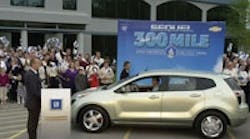UK scientists reported in late May a breakthrough in hydrogen storage technology that could eventually make mass marketing of fuel-cell-powered cars a reality.
The team, consisting of researchers from the universities of Birmingham and Oxford and the Rutherford Appleton Laboratory, has developed a compound of lithium that can store enough hydrogen aboard a fuel-cell-powered car to keep it running for as long as 300 miles before refueling. (Three hundred miles has been cited as the range necessary to commercialize fuel cell cars.) Size and weight issues related to the use of hydrogen as fuel for passenger vehicles have proven major barriers to commercialization efforts.
The UK team's approach has focused on enabling hydrogen to be stored at a much higher density while maintaining acceptable weight limits using a process called "chemisorption." Their efforts included the testing of thousands of solid-state compounds to find "a light, cheap, readily available" material that would allow the absorption and de-absorption process to occur safely at typical fuel cell operating temperatures. The scientists have now produced a variety of lithium hybrid that may offer the right blend of properties.
See Also





